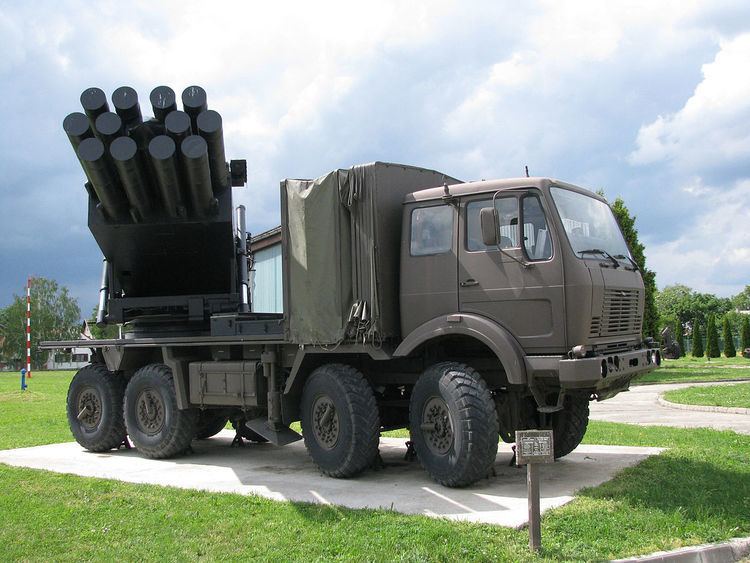Length 9 m (29 ft 6 in) | Weight 32t Width 2.64 m (8 ft 8 in) | |
 | ||
Designer Military Technical Institute Belgrade | ||
The M-87 Orkan is a Yugoslavian self-propelled multiple rocket launcher. The generic M-87 project was configured with 12 launch tubes mounted on a FAP 2832 truck. It has a range of about 50 to 120 km, able to deliver warheads, anti-tank and anti-personnel mines. Very few of these were ever built, The production of Orkan M-87 ceased in the early 1990s due to break-up of Socialist Federal Republic of Yugoslavia.
Contents
History
Development started as a joint Iraqi and SFRY project under the name of KOL-15. In early talks with Iraq, Yugoslavia offered two options:
Iraq chose the first option as did Yugoslavia.
At the start of development two prototypes were built: one for Yugoslavia and one for Iraq. In accordance with requests from purchasers, rockets were developed with cluster warheads.
According to the chief operating officer of the Artillery department of Military Technical Institute Professor Obrad Vucurovic, Orkan was never a copy of any previous designs. The Yugoslav doctrine when developing the system was based on the premise that countries who copy designs are at least five years behind those who have the weapons developed.
Characteristics
One battery of M-87 Orkans consist of:
The FAP 2832 vehicle with its base platform is fitted with a central tyre pressure regulation system which is operated by the driver from within the cab, and to provide a more stable firing platform four stabilisers are lowered to the ground by remote control one at either side to the rear of the second roadwheel and two at the very rear. When travelling, the launcher is traversed to the front and the whole launcher is covered by a tarpaulin cover with integral bows.
Rockets
The rocket is 4.6 metres long and it is packed in a glass-ceramic housing and transported by the vehicle. Rockets are re-loaded by the FAP 3232 with a built-in crane. The rocket speed is 1000 m/s. Extended range rockets are 4.88 m long and weigh 404 kg. Extended range rockets are produced for a new Serbian version of the Orkan by Edepro Belgrade. A battery of 4 launchers with 16 barrels and 192 rockets cover a target area of 3–4 km².
The following types of rockets are known:
Some of rockets are not longer in production.
Features
Unique features at the time of introduction (1987) when compared to other MRLs operational at the time include:
Loading was semi-automatic from the vehicle with reserve rockets. Rockets were carried by crane and lowered onto the loading device after which the rocket was automatically loaded in barrel.
The system for automatic levelling would record I,II and III fired missile paths then navigate the barrels as needed.
According to the chief operating officer of the Artillery department of Military Technical Institute Professor Obrad Vucurovic, Orkan's main feature was the ability to disperse anti-tank or anti-personnel mines from 5 to 50 km from the firing location.
Modifications and versions
There were a few modifications of Orkan M-87:
Operational history
Serbs from Croatia used it to attack military and civilian targets in Croatia from 1991. After Operation Flash in 1995, it was used alongside cluster munitions by the Republic of Serbian Krajina (RSK) to kill Croatian civilians in Zagreb in an event called Zagreb rocket attacks.
